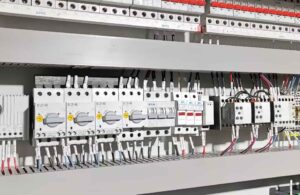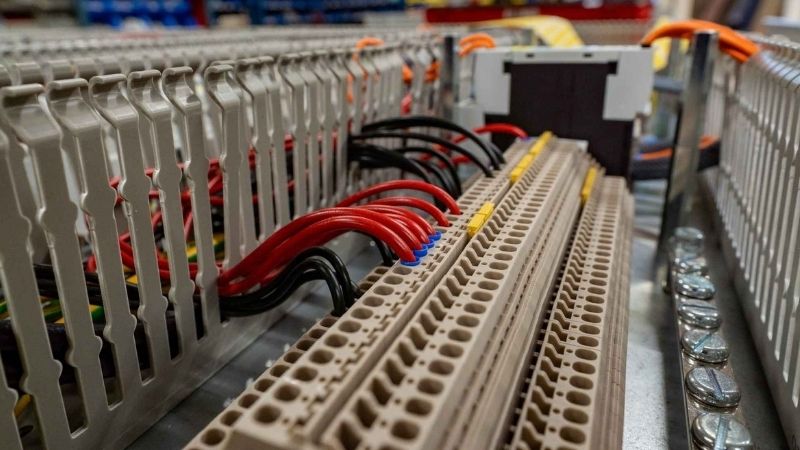24ВДЦ наспрам 120ВАЦ: Разумевање разлика у аутоматизацији
Било да сте инжењер, техничар или менаџер набавке, овај водич је препун корисних увида који ће вам помоћи да се снађете у овој важној одлуци.
Садржај
Шта је 24ВДЦ и зашто се користи у аутоматизацији?
24ВДЦ се широко користи у аутоматизацији јер је погодан за уређаје мале снаге, укључујући сензоре, релеје и ПЛЦ-ови. Контролна кола од 24ВДЦ су генерално безбеднија од 120ВАЦ јер нижи напон смањује ризик од електричног удара. У контролним панелима и индустријским системима, 24ВДЦ се често користи у соленоидима, сензори, и контролно ожичење.
Ово нисконапонско напајање осигурава да кола остану безбедна и поуздана, и минимизира ризик од електричних пожара. За аутоматске апликације које захтевају прецизну контролу, 24ВДЦ нуди предност стабилније снаге и ниже ампераже, што је кључно за осетљиву опрему.
Кључне предности:
- Сигурност: Нижи напон значи мањи ризик од струјног удара или повреда.
- Поузданост: 24ВДЦ системи су мање подложни паду напона или сметњама.
- Ефикасност: Нижи захтеви струје смањују потрошњу енергије, што га чини идеалним за континуирани рад.
Које су предности 120ВАЦ за контролне системе?
Док се 120ВАЦ често користи у већој опреми, такође је уобичајен у индустријским контролним системима. Међутим, 120ВАЦ се првенствено користи за оптерећења и машине велике снаге. Контролна кола су обично напајана на 24ВДЦ у многим индустријским системима како би се побољшала сигурност, смањили пад напона и осигурао поуздан рад.
Један од главних разлога зашто се 120ВАЦ широко користи у контролним системима је његова доступност и способност преноса енергије на велике удаљености. Пошто виши напони захтевају мање струје за пренос исте количине енергије, системи од 120 ВАЦ могу бити ефикаснији за одређене примене.
Кључне предности:
- Виша моћ: Погодно за веће системе, опрему или машине којима је потребно више енергије.
- Дуже удаљености: 120ВАЦ се може преносити преко дужих жица без значајног пада напона.
- Исплативо: Лакше за имплементацију у областима где је 120ВАЦ лако доступан.
Како се 24ВДЦ контрола разликује од 120ВАЦ контроле?
Када упоредимо 24ВДЦ са 120ВАЦ у контролним круговима, кључне разлике леже у безбедности, сложености ожичења и типовима подржане опреме. На пример, контролна кола од 24 ВДЦ су често једноставнија и захтевају мање заштите, док контролна кола од 120 ВАЦ могу захтевати додатне компоненте као што су прекидачи, осигурачи и робуснији системи ожичења.
24ВДЦ системи су генерално поузданији за мање контролне апликације и широко се користе у ПЛЦ-овима и сензорима мале снаге. С друге стране, контролни системи од 120 ВАЦ су прикладнији за апликације где је потребна већа снага, као нпр мотори и велике индустријске опреме.
24ВДЦ контрола:
- Поједностављено ожичење.
- Идеалан за мање уређаје мале снаге.
- Повећана безбедност са минималним ризиком од излагања високом напону.
120ВАЦ контрола:
- Често се користи за машине велике снаге.
- Захтева више заштитних и безбедносних мера.
- Подржава веће, енергетски интензивније уређаје.
24ВДЦ вс 120ВАЦ: Који напон треба да користите?
Поређење 24ВДЦ и 120ВАЦ у великој мери зависи од потреба за напајањем и апликације. За мању опрему за аутоматизацију и контролна кола, 24ВДЦ је обично боља опција. Међутим, 120ВАЦ је прикладнији избор за веће машине и за пренос енергије на велике удаљености због своје способности да носи већу амперажу са мањим губицима енергије на даљину.
Насупрот томе, 120ВАЦ је погоднији за машине, моторе или опрему велике снаге где су виши напони неопходни за оптималне перформансе. Узмите у обзир следеће факторе када одлучујете који напон ћете користити:
Фактори које треба узети у обзир:
- Захтеви за напајање: Ако вашем систему треба више енергије, 120ВАЦ би могао бити бољи избор.
- Сигурност: За системе који захтевају често одржавање или укључују оператере, 24ВДЦ нуди сигурнију опцију.
- Удаљеност: За даљинско ожичење, 120 ВАЦ је ефикаснији, јер смањује струју и минимизира пад напона.
Како решити проблеме са напоном у системима аутоматизације?
Када се појаве проблеми у системима аутоматизације, решавање проблема повезаних са напоном често је први корак. Проблеми као што су пад напона, неисправно напајање или квар опреме могу изазвати значајне поремећаје у индустријској аутоматизацији.
Уобичајени проблеми са напоном:
- Волтаге Дроп: На великим удаљеностима, напон може пасти, што доводи до неефикасне испоруке енергије. У системима од 24ВДЦ, ово је посебно приметно у управљачким колима, која су осетљива и на мале падове напона.
- Неправилан напон: Уверите се да се користи исправна 24ВДЦ контрола или 120ВАЦ напајање за одређену примену. Коришћење погрешног напона може оштетити осетљиве компоненте.
- Неисправности опреме: Проблеми са трансформаторима, релејима или ПЛЦ-овима могу настати због неусклађености напона.
Савети за решавање проблема:
- Проверите напајање: Уверите се да извор напајања обезбеђује исправан напон за систем.
- Прегледајте ожичење: Прегледајте контролно ожичење на оштећења, корозију или неправилне везе.
- Меасуре Волтаге: Користите мултиметар да измерите стварни напон на улазним и излазним тачкама система како бисте били сигурни да је унутар очекиваног опсега.
Често постављана питања
Која је разлика између 24ВДЦ и 120ВАЦ у индустријској аутоматизацији?
24ВДЦ се користи за апликације мале снаге као што су ПЛЦ-ови и сензори, нудећи сигурност и енергетску ефикасност, док је 120ВАЦ погодно за апликације веће снаге као што су мотори и веће машине.
Да ли је 24ВДЦ сигурнији од 120ВАЦ?
Да, 24ВДЦ се сматра сигурнијим јер представља мањи ризик од електричног удара у поређењу са вишим напоном од 120ВАЦ.
Да ли могу да користим 120ВАЦ за контролна кола уместо 24ВДЦ?
Док се 120ВАЦ може користити за контролна кола, генерално је резервисан за апликације велике снаге. 24ВДЦ је погоднији за управљачка кола у аутоматизацији због своје сигурности и поузданости.
Како да решим проблем пада напона у систему од 24 ВДЦ?
Измерите напон на различитим тачкама система и проверите да ли су спојеви лабави или оштећено ожичење. Пад напона је најуочљивији на великим удаљеностима, па се побрините да ваше ожичење одговара удаљености.
Шта је енергетски ефикасније, 24ВДЦ или 120ВАЦ?
24ВДЦ је типично енергетски ефикаснији за мање системе, јер захтева мање струје и идеалан је за уређаје мале снаге. 120ВАЦ је ефикаснији за пренос енергије на велике удаљености.
Напајајте своје пројекте са потпуно новим, оригиналним Омрон, Митсубисхи, Сцхнеидер ПЛЦ – на лагеру, спремни одмах!
Закључак
- 24ВДЦ је идеалан за апликације мале снаге, пружајући сигурност и енергетску ефикасност у контролним круговима.
- 120ВАЦ је погоднији за машине и опрему велике снаге, посебно тамо где је неопходан пренос енергије на велике удаљености.
- Избор између 24ВДЦ и 120ВАЦ зависи од захтева за напајањем, забринутости за безбедност и ефикасности потребне за ваш систем аутоматизације.
- Увек се уверите да користите исправан напон за своју опрему како бисте избегли оштећење или неефикасност.
Узимајући у обзир ове факторе, можете донети информисанију одлуку која обезбеђује поузданост, безбедност и ефикасност ваших система индустријске аутоматизације.
Тражите нове, оригиналне ПЛЦ-ове за своје пројекте? У Квоцо-у имамо најновије ПЛЦ-ове врхунских брендова као што су Омрон, Митсубисхи, и Сцхнеидер. Купујте са поверењем — брза испорука, загарантован квалитет! Купи одмах
Контактирајте нас
Само попуните своје име, адресу е-поште и кратак опис вашег упита у овом обрасцу. Контактираћемо вас у року од 24 сата.
Ове теме могу такође бити интересантне

Релеји: Водич за типове и апликације
Овај чланак пружа дубински поглед на релеје, неопеване хероје многих електричних система. Истражићемо различите типове релеја, њихове примене и како функционишу. Било да сте инжењер, техничар или једноставно радознали како ствари функционишу, овај свеобухватни водич ће осветлити фасцинантан свет релеја.

Сиеменс против Омрон ПЛЦ: Која је права за ваш пројекат?
Када бирам ПЛЦ, често ме питају: „Који је бољи: Сиеменс или Омрон?“ То је комплексно питање. Као инжењер у Квоцо-у, мој савет је да одабир ПЛЦ-а није у вези са тим који је бренд бољи, већ који одговара вашим специфичним потребама.

Како да решите проблеме са преузимањем Сиеменс ПЛЦ програма?
Како да решите проблеме са преузимањем Сиеменс ПЛЦ програма? Да ли сте икада имали Сиеменс ПЛЦ програм који једноставно није хтео да преузме






